|
|
|
Sort Order |
|
|
|
Items / Page
|
|
|
|
|
|
|
| Srl | Item |
| 1 |
ID:
183753
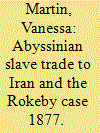

|
|
|
|
|
| Summary/Abstract |
In March 1877, the British searched a ship named The Rokeby and discovered eight Abyssinian child slaves on board. It is argued that, hitherto frustrated by the constant evasion of their attempts to supress the slave trade, they used the event to bring pressure on local government officials and merchants of Bushehr to cease their collusion and involvement. The result was a decline in the trade at least in the coast around Bushehr. There having been hitherto no specific studies of the Abyssinian slave trade to Iran, the case has also been taken as an opportunity to discuss it from its country of origin through Mecca and Jeddah, then in Ottoman territory, and to the Gulf ports of Iran, which allows an indicative comparison of Ottoman and Iranian policies of suppression. Rare insight has been provided into the experiences of the slaves themselves by the first-hand accounts of their journeys from Abyssinia given to the British.
|
|
|
|
|
|
|
|
|
|
|
|
|
|
|
|
| 2 |
ID:
045523
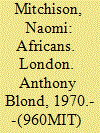

|
|
|
|
|
| Publication |
London, Anthony Blond, 1970.
|
| Description |
232p.hbk
|
|
|
|
|
|
|
|
|
|
|
|
Copies: C:1/I:0,R:0,Q:0
Circulation
| Accession# | Call# | Current Location | Status | Policy | Location |
| 005752 | 960/MIT 005752 | Main | On Shelf | General | |
|
|
|
|
| 3 |
ID:
155119
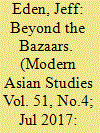

|
|
|
|
|
| Summary/Abstract |
The slave trade in nineteenth-century Central Asia involved hundreds of thousands of slaves, predominantly Persian Shīʿites, and stopping the trade was alleged to be a major motivating factor in the Russian conquest of the region. Nevertheless, Central Asian slavery remains little-studied and little-understood. In this article I will argue, first, that the region's slave trade was characterized by decentralized trade networks and by abundant inter-nomadic trade; and, second, that Russian efforts to end the slave trade by decree and through military force in the 1860s and 70s were not as successful as has often been assumed.
|
|
|
|
|
|
|
|
|
|
|
|
|
|
|
|
| 4 |
ID:
044218
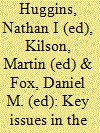

|
|
|
|
|
| Publication |
New York, Harcourt Brace Jonanovich Inc, 1971.
|
| Description |
xv, 272p.
|
| Standard Number |
0155483714
|
|
|
|
|
|
|
|
|
|
|
|
Copies: C:1/I:0,R:0,Q:0
Circulation
| Accession# | Call# | Current Location | Status | Policy | Location |
| 007368 | 305.896073/HUG 007368 | Main | On Shelf | General | |
|
|
|
|
| 5 |
ID:
074938
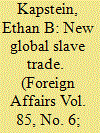

|
|
|
|
|
| Publication |
2006.
|
| Summary/Abstract |
Most people think of slavery as a purely historical phenomenon. In fact, the practice thrives around the world today. The same factors that contribute to economic globalization have given rise to a booming international traffic in human beings, often with the connivance of national governments. Fighting this scourge successfully will take more than another UN treaty: Western nations must use their military might.
|
|
|
|
|
|
|
|
|
|
|
|
|
|
|
|
| 6 |
ID:
115363
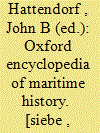

|
|
|
|
|
| Publication |
New York, Oxford University Press, 2007.
|
| Description |
722p.
|
| Contents |
Incloudes Index
Vol.4
Four vol.set price $625.00
|
| Standard Number |
9780195130751
|
|
|
|
|
|
|
|
|
|
|
|
Copies: C:1/I:0,R:0,Q:0
Circulation
| Accession# | Call# | Current Location | Status | Policy | Location |
| 056812 | 623.803/HAT 056812 | Main | On Shelf | General | |
|
|
|
|
| 7 |
ID:
030765
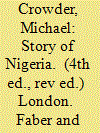

|
|
|
|
|
| Edition |
4th ed., rev ed.
|
| Publication |
London, Faber and Faber, 1978.
|
| Description |
365p.hbk
|
| Standard Number |
057104946X
|
|
|
|
|
|
|
|
|
|
|
|
Copies: C:1/I:0,R:0,Q:0
Circulation
| Accession# | Call# | Current Location | Status | Policy | Location |
| 017659 | 966.9/CRO 017659 | Main | On Shelf | General | |
|
|
|
|
| 8 |
ID:
104254
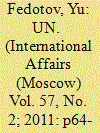

|
|
|
|
|
| Publication |
2011.
|
| Summary/Abstract |
Armen Oganesyan, Editor-in-Chief of International Affairs: When one decides to take charge of as important an organization as the UN Office on Drugs and Crime (UNODC), they draw up an action plan and decide on their priorities. Which goals did you set yourself and which of them are top priority?
Yuri Fedotov: I am currently the head of the UN Office on Drugs and Crime while being also in charge of the UN office in Vienna to coordinate the operation of several international organizations (the UN Office for Outer Space Affairs, UNCITRAL, etc.).
|
|
|
|
|
|
|
|
|
|
|
|
|
|
|
|
| 9 |
ID:
152366
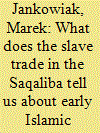

|
|
|
|
|
| Summary/Abstract |
The Saqaliba—a term that in medieval Arabic literature denoted the Slavic populations of central and eastern Europe (and possibly some of their neighbors)—offer a particularly insightful case study of the mechanisms of the early Islamic slave trade and the nature of the Muslim demand for slaves. What makes them such an ideal case study is their high visibility in texts produced in the Islamic world between the early 9th and early 11th centuries. Arab geographers and diplomats investigated their origins, while archaeological material, primarily hundreds of thousands of dirhams found in Scandinavia and the Slavic lands, contains traces of the trade in them. By combining these strands of evidence, we can build an exceptionally detailed image of slave trade systems that supplied Saqaliba to the Islamic markets, which, in turn, can be used to illustrate more general mechanisms governing the trade in and demand for slaves in the medieval Islamic world.
|
|
|
|
|
|
|
|
|
|
|
|
|
|
|
|
| 10 |
ID:
174996
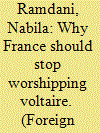

|
|
|
|
|
|
|
|